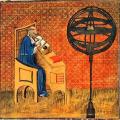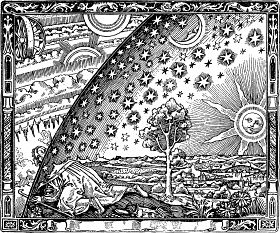280. Get to the Point: Fourteenth Century Physics
Ockham, Buridan, Oresme and Francis of Marchia explore cosmology, atomism, and the impetus involved in motion.
Themes:
• S. Caroti and P. Souffrin (eds), La nouvelle physique du XIV siècle (Florence: 1997).
• M. Clagett, The Science of Mechanics in the Middle Ages (Madison: 1961).
• R. Cross, The Physics of Duns Scotus: the Scientific Context of a Theological Vision (Oxford: 1998).
• J. Davies (trans.) Ockham on Aristotle’s Physics: A Translation of Ockham’s Brevis Summa Libri Physicorum (St. Bonaventure: 1989).
• A. Goddu, The Physics of William of Ockham (Leiden: 1984).
• E. Grant, A Source Book in Medieval Science (Cambridge, MA: 1974).
• C. Grellard and R. Aurélien (eds), Atomism in Late Medieval Philosophy and Theology (Leiden: 2009).
• E. Grant, The Nature of Natural Philosophy in the Late Middle Ages (Washington DC: 2010).
• N. Kretzmann (ed.), Infinity and Continuity in Antiquity and Medieval Thought (Ithaca: 1982).
• A. Maier, On the Threshold of Exact Science: Selected Writings of Anneliese Maier on Late Medieval Natural Philosophy, ed. and trans. S.D. Sargent (Philadelphia: 1982).
• F. Zanin, “Francis of Marchia, Virtus derelicta, and Modifications of the Basic Principles of Aristotelian Physics,” Vivarium 44 (2006), 81-95.
• J. Zupko, “Nominalism Meets Individualism,” Medieval Philosophy and Theology 3 (1993), 158-85.







Comments
Buridan and inertia
16:27 - "Note that this is not the same as the later scientific concept of inertia. Neither Marchia nor Buridan claim that moving bodies continue moving by default, slowing or stopping only when impeded"
17:00 - "The heavens are quite literally the exception that proves this rule (...). Rather the sphere is moved by an externally imposed force."
Now I haven't read Buridan and unfortunately I don't have access to his work (I really wish I did), so I have no way of verifying this, but the following quotes given on Wikipedia contradict what you said there:
"After leaving the arm of the thrower, the projectile would be moved by an impetus given to it by the thrower and would continue to be moved as long as the impetus remained stronger than the resistance, and would be of infinite duration were it not diminished and corrupted by a contrary force resisting it or by something inclining it to a contrary motion." (Jean Buridan, Questions on Aristotle's Metaphysics XII.9: 73ra; quoted by T. F. Glick, S. J. Livesay, F. Wallis, Medieval Science, Technology and Medicine: an Encyclopedia, 2005, p. 107).
"God, when He created the world, moved each of the celestial orbs as He pleased, and in moving them he impressed in them impetuses which moved them without his having to move them any more... And those impetuses which he impressed in the celestial bodies were not decreased or corrupted afterwards, because there was no inclination of the celestial bodies for other movements. Nor was there resistance which would be corruptive or repressive of that impetus." (Jean Buridan, Questions on Aristotle's Physics VIII.12; English translation in Clagett's 1959 Science of Mechanics in the Middle Ages p. 536).
Based on this it seems that Buridan did discover inertia and in fact clearly formulates Newton's first law of motion, which is quite the paradigm shift. Not only that, but he applies his idea of inertia to correctly explain the continuous movement of celestial bodies. It's also worth mentioning that his impetus is quite literally what we call momentum, since he gives the same formula for it: weight multiplied by velocity (the only difference is that we would say mass rather than weight, but that distinction didn't exist yet).
If those quotes are correct, is it possible your sources are drawing on Buridan's earlier writings?
In reply to Buridan and inertia by Zarl
Impetus vs inertia
I can see why you are saying that but if you look at your first quote more carefully you'll see that it shows Buridan actually does have impetus in mind, not inertia. The theory of impetus is that the mover bestows upon the moving projectile a force for locomotion. So when he says it "would continue to be moved as long as the impetus remained stronger than the resistance" the idea is that the impressed force will keep the projectile moving as long as this force is not worn down by the resistance. By contrast the inertia theory is simply that things, once in motion, keep moving unless something prevents it (and when at rest, stay at rest). At least this is how I understand it. Similarly the second passage has in mind that God impresses a force for continued motion in the heavens and this is never worn down so the force keeps them going indefinitely.
In reply to Impetus vs inertia by Peter Adamson
Impetus = momentum
But Buridan's impetus isn't a force applied to the object externally, if that's what you mean. It's a property of the object which is originally given to it by an external force, but which then resides within the object, without need of any further outside intervention. That property is tied only the the object's weight and velocity. Here's another quote, part of his definition of impetus, which makes this clear: "When a mover sets a body in motion he implants into it a certain impetus"; "The implanted impetus increases in the same ratio as the velocity". This is exactly how we understand momentum. When an object is put in motion it acquires momentum, and that momentum can be diminished if the object encounters resistance or any other contrary force. Otherwise, the momentum is preserved and the motion is unaffected indefinitely. And that right there is the law of inertia: every object in a state of uniform motion will remain in that state of motion unless an external force acts on it. That law is, in slightly different wording, entirely contained in the quote from the Questions on Metaphysics.
Replace "impetus" with "momentum" and "weight" with "mass", and everything Buridan says could be from a modern textbook on classical mechanics. Except one thing, which is that he believes there can be an impetus not only for a rectilinear but also for a circular motion. This is of course to explain the circular motion of heavenly bodies, since he doesn't know about the force of gravity.
In reply to Impetus = momentum by Zarl
Impetus vs inertia
I don't think that's right, though I think what you are articulating is probably what most laypeople assume inertia and momentum to mean. The law of inertia doesn't say that a force is impressed into a moving body and kept by that body, like liquid that has been poured into a vessel. It simply says that motion (or rest) will continue unless something prevents it. A nice case to illustrate this would be a box sitting unfixed on the bed of a truck. If the truck crashes, the box will slide forward because of its tendency to retain its forward motion. Buridan by contrast would have to say something like, the truck's impressed power for moving has encountered more resistance than the box has. Or imagine a cup of water that is suddenly pushed forward: the water will slosh backwards, "trying" to remain at rest. This is not something Buridan seems to have noticed or could explain with his theory, as far as I can see.
If you still think there is no difference you should probably argue with a physicist, not with me (not least because I don't necessarily know what I'm talking about), but also you shouldn't get excited only about Buridan but about Philoponus who already had the idea of impressed force in late antiquity. And there are similar ideas in the Islamic world, in particular in Ibn Bajja and Abu l-Barakat al-Baghdadi, as I mention in those epsiodes.
In reply to Impetus vs inertia by Peter Adamson
Momentum and inertia
As it happens I'm not quite as much of a layperson when it comes to physics as when it comes to philosophy. Your formulation of the law of inertia is correct, and like I pointed out it's contained in Buridan's quote: (the motion) "would be of infinite duration were it not diminished and corrupted by a contrary force resisting it or by something inclining it to a contrary motion." The idea Buridan adds to this is that the motion is driven by impetus/momentum. This is a perfectly adequate way of looking at it. It doesn't have to be framed as one causing the other, but that's just a matter of semantics. Motion and momentum are just two things that go together for any object with mass, and Buridan clearly understood that when he correctly defined impetus/momentum as the product of velocity and mass. And we absolutely understand momentum as being acquired when a force is applied to an object: momentum is force multiplied by time, and the act of throwing can be represented as a transfer of kinetic energy (energy in turn is force multiplied by distance). All this is related to Newton's second law of motion, which Buridan is not very far from understanding at all.
The words you put in Buridan's mouth about the box on the truck are just as true. The truck's momentum was broken by an opposing force, while the box's momentum was not. This is perfectly correct. The same principle applies to the water in the glass, motion just becomes more complex when you look at liquids. But imagine a coin in the glass instead, and what happens is that the force applied to the glass gives it a momentum which is only transmitted to the coin once it hits the back of the glass and thus has a force applied to it (assuming of course that it slides on the bottom without resistance).
I'm well aware that momentum and the law of inertia are two different things (not least because one is a quantity while the other is a law of physics), and so is Buridan. He just establishes the concept of impetus/momentum and formulates the law of inertia in the same sentence because they're linked.
By contrast, from what I've seen Philoponus' impetus is more like what you described: an exterior force that continues to act upon the body, but only temporarily. Abu'l Barakat's impetus seems to be similar, with the addition that the impetus depletes in proportion to the object's distance from the original mover. Neither of those are really momentum, they seem more like a partial force that acts from a distance. And there's most definitely no inertia since this impetus depletes on its own. In fact they're exactly what you described, it kind of seems like you're understanding Buridan's mechanics as being identical to those more ancient theories of impetus, when in fact he only uses the same word but applies it to a revolutionary concept.
If you'd like I could ask an actual physicist to verify all of this.
In reply to Momentum and inertia by Zarl
Impetus again
Ah ok, so it sounds like we are after all on the same page as far as the physics goes and the question is after all where we started, namely to what extent Buridan did anticipate momentum/inertia theory rather than being closer to what we find in Philoponus. My understanding of the scholarly consensus on this is that he's seen as a forerunner of the modern physics view, along with Philoponus, but not as having clearly articulated it himself - precisely because he doesn't separate the notion of impetus from the notion of an impressed force. But it would obviously be worth going back to the primary texts and the secondary literature I recommend on this episode.
In reply to Impetus again by Peter Adamson
Momentum, inertia, and primary sources
Right, whether Buridan should be hailed as the original founder of classical mechanics or just as another forerunner is a matter of appreciation. But in any case he did understand inertia and formulate the law of inertia, and his impetus is not an externally imposed force like it is in Philoponus, but rather matches exactly our modern understanding of momentum, that much should be admitted. And in my opinion that's a major paradigm shift.
That is of course provided the quotes I gave are correct. Distressingly, I couldn't find either his Questions on Physics or his Questions on Metaphysics in any language (except for an entirely illegible scan of the Metaphysics in Latin on the BnF site), making me wonder if they've even been fully translated at all. I've had the same problem trying to find some other medieval works mentioned in this series.
I just had a look at your
I just had a look at your published "Medieval Philosophy" book, and I must say I'm quite disappointed that you chose to completely ignore my objections and keep the lines I quoted in my first comment, even after I showed you direct quotes by Buridan which show that they're false. I understand you're not interested in doing original research but only in popularisation of established consensus, but you could at the very least refrain from repeating blatant untruths after having been confronted about them.
In reply to I just had a look at your by Zarl
Buridan
Well, to be honest I wasn't actually that convinced by you back when we discussed this - like I said it's worth looking into but the passages you presented seem compatible with the standard interpretation to me. If you want to challenge that interpretation I'd encourage you to research it further and publish your ideas!
In any case you are underestimating how long it takes for books to go through the publication process: your original comments came several months after I submitted the book to press, though before it appeared in print. So when we talked about it before I guess I never thought about it in the context of possibly revising the book, because it was already too late.
In reply to Buridan by Peter Adamson
They are definitely not
They are definitely not compatible with those two particular quotes from your podcast and book. But fair enough about the publication times.
Add new comment